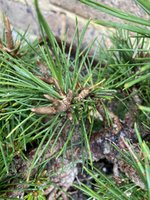Hi all,
Couple of newbie questions here.
Firstly, it’s late Autumn here in Sydney for those in the northern hemi.

Perhaps the easiest; can i/should i prune some of these buds to prevent whorls forming? I’m aware of the decandling/shoot selection technoques but are these too under-developed? Most see to select between actual shoots rather than these are this coming springs new buds?
The tree’s still in early development but due to pre-existing whorls/swelling i’d like to keep a few trunk-paths and lower branch options open/whorl free. Should i thin this out now before further growth and energy is expended on so many buds?
The other question refers to 2 different JBP’s i have in different locations and soils. Any suggestions as to what may be causing the yellowing/occasional ringing; and perhaps more importantly the clumped ‘cut’/died back needles?

Also the larger one in particular has (below) predominantly 3 and even 4 needles per wrapper it seems, but only on some of this years candles; is this odd?

Some notes; Its rained extensively here in Sydney the past month and it’s possible i may have over fertilized (although i wouldn’t have thought so?).
They’re both in garden beds so can’t really be moved from the rain.
I also noticed a bunch of centipedes (not curl grub) about, however i couldn’t visibly see any other pests about.
Any advice as to whether i should be concerned and if so, what might be a good course of action?
Thanks all; and sorry for the tedious newbie Q’s.
Couple of newbie questions here.
Firstly, it’s late Autumn here in Sydney for those in the northern hemi.

Perhaps the easiest; can i/should i prune some of these buds to prevent whorls forming? I’m aware of the decandling/shoot selection technoques but are these too under-developed? Most see to select between actual shoots rather than these are this coming springs new buds?
The tree’s still in early development but due to pre-existing whorls/swelling i’d like to keep a few trunk-paths and lower branch options open/whorl free. Should i thin this out now before further growth and energy is expended on so many buds?
The other question refers to 2 different JBP’s i have in different locations and soils. Any suggestions as to what may be causing the yellowing/occasional ringing; and perhaps more importantly the clumped ‘cut’/died back needles?

Also the larger one in particular has (below) predominantly 3 and even 4 needles per wrapper it seems, but only on some of this years candles; is this odd?

Some notes; Its rained extensively here in Sydney the past month and it’s possible i may have over fertilized (although i wouldn’t have thought so?).
They’re both in garden beds so can’t really be moved from the rain.
I also noticed a bunch of centipedes (not curl grub) about, however i couldn’t visibly see any other pests about.
Any advice as to whether i should be concerned and if so, what might be a good course of action?
Thanks all; and sorry for the tedious newbie Q’s.
